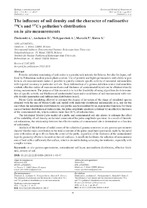| dc.contributor.author | Zhukouski, A. | en |
| dc.contributor.author | Anshakou, O. | en |
| dc.contributor.author | Nichyparchuk, A. | en |
| dc.contributor.author | Marozik, P. | en |
| dc.contributor.author | Kuten, S. | en |
| dc.coverage.spatial | Минск | ru |
| dc.date.accessioned | 2018-03-17T13:47:59Z | |
| dc.date.available | 2018-03-17T13:47:59Z | |
| dc.date.issued | 2018 | |
| dc.identifier.citation | The influence of soil density and the character of radioactive ¹³⁴Cs and ¹³⁷Cs pollution’s distribution on in situ measurements = Влияние плотности почвы и характера распределения радионуклидов ¹³⁴Cs и ¹³⁷Cs по профилю при in situ измерениях / A. Zhukouski [et al.] // Приборы и методы измерений : научно-технический журнал. - 2018. – Т. 9, № 1. – С. 40-47. | ru |
| dc.identifier.uri | https://rep.bntu.by/handle/data/38815 | |
| dc.description.abstract | Periodic radiation monitoring of soils today is a priority task not only for Belarus, but also for Japan, suffered by Fukushima nuclear power plant accident. Use of portable and light spectrometers with ability to perform in situ measurements makes it possible to quickly estimate specific activity of measured radionuclides with required accuracy in particular soil site. Basic information of a gamma radiation source (radionuclides content, effective radius of measurement area and thickness of contaminated layer) can be obtained directly during measurement. The purpose of this research is to test the feasibility of using algorithms for determination of specific activity and thickness of contaminated layer under conditions of soil measurement with variable density parameters and radiocesium distribution in soil. Monte-Carlo simulating allowed to estimate the degree of deviation of the shape of simulated spectra obtained with the use of Monte-Carlo soil model with uniformly distributed radionuclide in it, and for the case when the radionuclide distribution by soil profile can be described by an exponential function. For these cases of natural distribution of radiocesium, the pulse-amplitude spectrum is formed by an effective thickness of the contaminated site, which contains more than 90 % of radionuclides. The developed Monte-Carlo model of a probe and contaminated soil site allows to estimate the effect of the variability of soil density on the total count rate of the pulse-amplitude spectrum. As a result of theoretical estimations, the relationship between the effective radius of contaminated site is determined as a function of soil density. Analysis of the influence of radial zones of the cylindrical gamma source on in situ gamma-spectrometer showed that the main contribution to the total count rate of the pulse-amplitude spectrum is made by the radial zone with radius of up to 40 cm from the center of the probe, regardless of the thickness of the contaminated layer in geometry «Probe is located on the soil surface». A small site facilitates the selection of measurement area of land with a sufficiently flat surface, which is desirable during surveying the territories, especially with complex terrain. | en |
| dc.language.iso | en_US | en |
| dc.publisher | БНТУ | ru |
| dc.subject | In situ gamma-spectrometer | en |
| dc.subject | Contaminated soil layer | en |
| dc.subject | Non-uniform distribution | en |
| dc.subject | Effective thickness | en |
| dc.subject | Density of soil | en |
| dc.subject | In situ гамма-спектрометр | ru |
| dc.subject | Загрязненный слой почвы | ru |
| dc.subject | Неравномерное распределение радионуклида | ru |
| dc.subject | Эффективная толщина | ru |
| dc.subject | Плотность почвы | ru |
| dc.title | The influence of soil density and the character of radioactive ¹³⁴Cs and ¹³⁷Cs pollution’s distribution on in situ measurements | en |
| dc.title.alternative | Влияние плотности почвы и характера распределения радионуклидов ¹³⁴Cs и ¹³⁷Cs по профилю при in situ измерениях | ru |
| dc.type | Article | ru |
| dc.identifier.doi | 10.21122/2220-9506-2018-9-1-40-47 | |
| local.description.annotation | Проведение периодического радиационного мониторинга почв на сегодняшний день является одной из приоритетных задач для обеспечения радиационной безопасности не только в Беларуси, пострадавшей от Чернобыльской катастрофы, но и в Японии, территории которой подверглись радиоактивному загрязнению в результате аварии на АЭС Фукусима. Цель настоящей работы заключалась в проверке возможности применения разработанных на основе упрощенной («равномерной») модели алгоритмов определения активности и толщины загрязненного слоя в условиях радиометрии почвенного покрова с вариативными параметрами плотности и распределения радиоцезия по глубине. Использование портативных in situ спектрометров позволяет оперативно оценить удельную активность контролируемых радионуклидов и плотность загрязнения почвы прямо на месте измерения и с необходимой точностью. Основная информация об источнике гамма-излучения (присутствующие радионуклиды, эффективный радиус участка и толщина загрязненного слоя) может быть получена непосредственно по результатам измерения аппаратурного спектра в сравнении с теоретическими (калибровочными) спектрами. Теоретические спектры рассчитывают путем имитационного моделирования процесса in situ измерений активности радионуклидов ¹³⁴Cs и ¹³⁷Cs, равномерно распределенных в однородной почвенной среде постоянной плотности. На практике следует учитывать приблизительность принятой модели измерений в отношении реального профиля заглубления радиоактивных загрязнений и изменчивости плотности исследуемых почв. Анализ влияния радиальных зон цилиндрического источника на интегральную скорость счета спектрометра показал, что основной вклад вносят радиальные зоны в радиусе до 40 см от центра устройства детектирования при расположении его на поверхности почвы вне зависимости от толщины загрязненного слоя. Небольшая по площади зона влияния облегчает выбор контролируемых участков земли с достаточно плоской поверхностью, что желательно при обследовании территорий, особенно со сложным рельефом. | ru |

